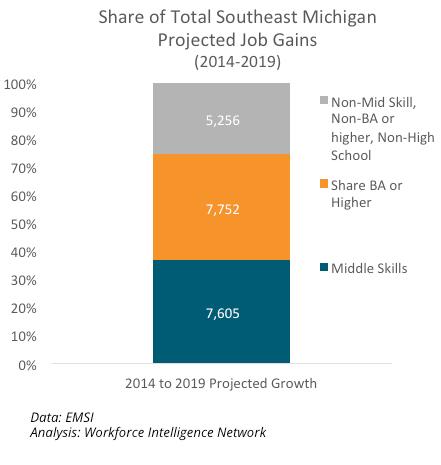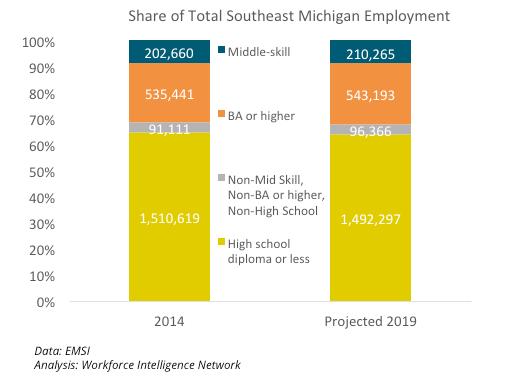WORKING SMARTER SERIES
April 2015


April 2015

THE IMPORTANCE OF POSTSECONDARY TRAINING TO ECONOMIC SUCCESS
Middle-skills jobs are those that require more than high school but less than a 4-year degree and pay over $15 per hour. There will be negative job growth in the coming years for jobs that currently only require a high school diploma and the jobs that will take their place are middle-skill. Employment prospects for those with a degree are still bright and middle-skill jobs can be part of a career pathway into more education and even more lucrative employment. With a shifting economic landscape post-secondary training, even if it isn’t a 4-year degree, is more important than ever. This research brief explores middle-skills jobs in Southeast Michigan. The information is separated into findings and three sections:

Findings
Major findings from WIN’s middle-skills research Page 3

Part 1
Middle-skill growth, data overview Page 4


Part 2
Top trending middle-skill jobs and training locations Page 6
Part 3
Middle-skill as a pathway to the middle class Page 9
COMMUNITY COLLEGES
Henry Ford College
Oakland Community College
Macomb Community College
Monroe County Community College
Mott Community College
Schoolcraft College
St. Clair County Community College
Washtenaw Community College
Wayne County Community College District
MICHIGAN WORKS! AGENCIES
Livingston County Michigan Works! Agency
Detroit Employment Solutions Corporation
Genesee-Shiawassee Michigan Works! Agency
Macomb-St.Clair Michigan Works! Agency & Workforce
Development Board
Oakland County Michigan Works! Agency
Southeast Michigan Community Alliance
Washtenaw County Michigan Works! Agency
37 percent of job growth in the coming five years will be in middle-skill jobs. These jobs are displacing “high-school diploma only” jobs by the thousands in Southeast Michigan.
There will be negative growth in jobs that do not require any postsecondary training. Jobs for workers with a high school education or less are disappearing. In order to find a job, some level of post-secondary training in an in-demand field is necessary.
The fastest growing middle-skill jobs are in the health sciences and other technology fields. Math, science, and technology skills are essential for many of the most in-demand middle-skill jobs.
Training for many of the top growing middle-skill jobs is available through Southeast Michigan’s community colleges. Many Michigan Works! agencies can also help workers pay for training in high-demand fields.
Each $1 per hour wage increase raises an individual’s annual salary by $2,080 (assuming a 40 hour week). This means that going from a $10 per hour job to a $15 per hour middle-skill job will move a worker’s annual wages from $20,800 to $31,200. Moving to $20 per hour will increase wages to $41,600 annually.
Middle-skills jobs are part of a career pathway to economic success. A middleskill job can be a long-term career or a stepping stone to more education and a higher paying job in the future.
POST-SECONDARY EDUCATION IS A MUST: PART 1



It turns out that education is more important than ever. Projections show that over the next five years (through 2019) there will be no aggregate growth in employment for jobs that require a high school diploma or less. In fact, the total number employees in jobs that require no post-secondary training will drop by 18,322 by 2019. While jobs for low-skill workers are vanishing, jobs that require post-secondary training are on the rise.

In the coming five years, employers in Southeast Michigan will add over 20,000 new jobs for workers with post-secondary education. 38 percent of the total will require a bachelor’s degree or higher and 37 percent of this total are considered “middle-skill”. Middle-skill jobs are those that pay a living wage (more than $15 per hour) and require more training than a high school diploma but do not require a bachelor’s degree. The remaining 25 percent of the job growth will be for jobs that do not require a BA (but require more than a high school diploma) but do not pay more than $15 per hour.
Workers without post-secondary training should not be too discouraged. Jobs that require a high school diploma or less have very high turn-over and the employers will still need a consistent stream of workers to fill open positions. Furthermore, while the total number of jobs that do not require education beyond high school is dropping, these jobs still represent over 65% of total employment.
Workers with no education beyond high school should be empowered to gain new credentials and skills. The message from the data is clear. If a worker wants to earn a living wage and have upward mobility, the only way is through additional education and training.
A bachelor’s degree is often a far reach for a worker with little resources and time. But post-secondary training through a certificate program or associate’s degree program is often more attainable. With 37 percent of coming job growth (over 7,500 new jobs by 2019) in middle-skill jobs that pay more than $15 per hour, a worker can increase their economic mobility and chances for future success by adding to their skills with a certificate or associate’s degree.
The difference in wages for workers who gain additional skills is tremendous. If a worker with no post-secondary training earns a certificate and finds one of the more
Share of Total Southeast Michigan Employment
than 7,500 new middle-skill jobs, their wage is likely to go from $10 per hour to $15 per hour. This would boost their annual salary from $20,800 to $31,200. A huge jump. In addition, most middle skill jobs pay more than $15 per hour and many pay upward of $20 per hour. This moves a worker’s annual salary to $41,600, very close to Michigan’s median family income of $48,000 per year.
Money talks and so does opportunity. Southeast Michigan’s future lies in an educated workforce with high-wage and high-skill jobs.*


Top trending middle-skill jobs in Southeast Michigan
It is increasingly clear that middle-skill jobs are critical for Detroit’s economic growth and for job seekers working to increase their wages. Middle-skill jobs have a clear definition, but what occupations fit the description and which ones are growing in this region?
WIN researchers have defined top trending middleskill jobs as those that are projected to grow by more than 10% through 2019. The table below highlights
Southeast Michigan’s current top trending middleskill jobs. All of the jobs listed below are projected to grow by at least 150 employees by 2019, net growth. The vast majority of these jobs are health care occupations, which are projected to grow rapidly as the state’s population ages and needs access to more health care. Right now, degree and certificate completions are close to demand for some occupations but not all. In 2013, there were no regional degree completions for workers certified as



chemical technicians yet there were nearly 100 job postings in the region for workers with these skills. For surgical technologists it looks as though supply is outpacing demand, but that may not be the case if workers are trained in the region but move away for work in other areas. Employers need to ensure an adequate supply of talent not only to grow their companies but also to replace workers when they retire or move on to other careers. Job posting demand reflects both replacement (or turnover) needs as well as increases. Completions are not necessarily enough to fill employer needs.
Where in Southeast Michigan can a worker go to increase their skills to be fit for one of the top ten middle-skill jobs? The region’s community colleges provide training in all but one of the top ten middle-skill fields and many additional areas.
The top in-demand jobs are also more prevalent in certain cities in the region. Detroit, Ann Arbor, Troy, Flint, and Southfield are among the top cities for middle-skill job demand. Not surprisingly, many health providers are also located in these cities.
Occupation
Community College Programs in Southeast Michigan
Chemical Technicians no community college programs
Medical and Clinical Laboratory Technicians
Cardiovascular Technologists and Technicians
Physical Therapist Assistants
Diagnostic Medical Sonographers
Paralegals and Legal Assistants
Veterinary Technologists and Technicians
Licensed Practical and Licensed Vocational Nurses
Emergency Medical Technicians and Paramedics
Surgical Technologists
Monroe County Community College
Macomb Community College
Henry Ford College
Henry Ford College
Macomb Community College
Mott Community College
Washtenaw Community College
Monroe County Community College
Mott Community College
Oakland Community College
Henry Ford College
Macomb Community College
Mott Community College
Oakland Community College
Wayne County Community College District
Macomb Community College
Wayne County Community College District
Henry Ford College
Monroe County Community College
Mott Community College
Oakland Community College
Schoolcraft College
St Clair County Community College
Henry Ford College
Macomb Community College
Mott Community College
Oakland Community College
Schoolcraft College
Wayne County Community College District
Henry Ford College
Macomb Community College
Oakland Community College
Wayne County Community College District
Middle-skill jobs are called middle-skill for a reason. They are often considered the mid-point along a career pathway that starts with an entry-level job, moves into a middle-skill job requiring more education, and could move to an even higher level job requiring even more education, training, and experience but also paying a higher wage. But how does a worker starting at the entry-level move into middle skill?
Middle-skill jobs are the mid-point on a career pathways for many workers but also are sustainable middle-class jobs in their own right.
While it is true that the fastest growing middle-skill jobs are in health care fields, there are plenty of other rapidly growing, in-demand middle-skill jobs in Southeast Michigan.
The below data compares 2013 and 2014 occupational demand for the top 15 middle-skill jobs with the highest rate of job posting and growth, relative to the number of 2013 graduates with certificates and degrees that align with these jobs.
The graphic shows 2013 postings in blue, related 2013 certificate and degree graduates in orange, and 2014 job postings in grey. Employer demand (as defined by postings) is a combination of turnover-related postings due to retirements and other separations as well as new jobs to be filled. Depending on the job, graduates in 2013 may or may not have been sufficient to meet employer demand that year. For some occupations, 2013 graduates outpaced employer demand, but for others there were not nearly enough new graduates to meet employer needs. As a result, postings remained high or grew from 2013 to 2014.
For example, demand for computer user support specialists in Southeast Michigan was at 3,789 postings in 2013. That same year 1,350 individuals (less than half the posting demand) completed certificates/degrees that would allow them to enter this line of work. In 2014 postings remained high at 3,535, signaling that more trained workers are needed to fill this growing occupation.
Generally speaking, there is substantial un-met demand for trained workers to fill growing middle-skill positions. For workers in entry-level retail and hospitality jobs, or for job seekers looking for a leg up into a more lucrative career, training for a middle-skill occupation might be a ticket to family-sustaining wages.
The top fifteen in-demand middle-skill jobs of 2014 are shown in the table below with detail on the typical entry-

Middle-Skill Supply/Demand
Top Job Postings and Related Grads (2013-2014 Southeast Michigan)
level education needed, 2014 job postings, and the median hourly earnings. Seven of the top jobs require postsecondary training without a degree. This is great news for job seekers that may not be able to commit the time and money to earning an associate’s degree. Many of in-demand middle skills jobs pay below $15 per hour at entry-level but have the potential to pay more with experience and related education and training.
How can a job seeker get a foot in the door for a middle-skill job? Federal and state workforce development dollars are available to help pay for training for many in-demand occupations. Local Michigan Works! agencies and onestop centers help qualified job seekers find training for in-demand occupations and can often assist with covering the costs of training.
This research brief was researched and prepared by Colby Spencer-Cesaro, Research Director at the Workforce Intelligence Network. To learn more about WIN see the website: www.win-semich.org
